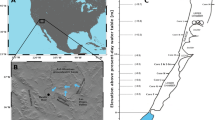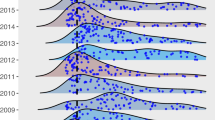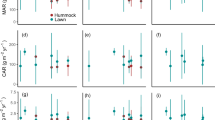Abstract
AMONG the most widely distributed mire types in North America are those maintained by the ground-water table, situated in topographic positions where water accumulates1. One type is the kettle-hole mire, which develops a buoyant mat over water bodies. Fossil pollen and peat macrofossil evidence indicate that kettle-hole mires in southwestern Ontario in Canada are approximately 150 years old. We hypothesize that deforestation for agriculture by the first European settlers reduced the regulating rates of seasonal runoff which caused the kettle-holes to flood in the spring. Pioneering bog species were placed at a competitive advantage which led to the establishment of floating carpets of vegetation over open water bodies.
This is a preview of subscription content, access via your institution
Access options
Subscribe to this journal
Receive 51 print issues and online access
$199.00 per year
only $3.90 per issue
Buy this article
- Purchase on SpringerLink
- Instant access to full article PDF
Prices may be subject to local taxes which are calculated during checkout
Similar content being viewed by others
References
Damman, A. W. H. & French, T. W. US Fish & Wildlife Serv., Biol. Report 85 (7:16) (1987).
Moore, P. D. & Bellamy, D. J. Peatlands (Springer, New York, 1974).
Crum, H. A. A Focus on Peatlands and Peat Mosses (University of Michigan Press, Ann Arbor, 1988).
Johnson, C. W. Bogs of the Northeast (University Press, New England, Hanover, 1985).
Rigg, G. B. Plant World 19, 310–325 (1916).
Boyko, M. thesis, Univ. Toronto (1973).
Gentilcore, R. L. & Donkin, K. Can. Cartogr. 10, Suppl. 2, 1–116 (1973).
Janusas, S. E. The Cultural Implications of Drainage in the Municapality of Waterloo (Regional Municipality of Waterloo, 1988).
McAndrews, J. H. in Vegetation History (eds Huntley, B. & Webb, T.) 673–697 (Kluwer Academic, Dordrecht, 1988).
Nichols, G. E. Bull. Torr. Bot. Club 42, 169–217 (1915).
Rigg, G. B. Bot. Rev. 6, 666–693 (1940).
Dachnowski, A. P. Plant World 15, 25–39 (1912).
Waterman, W. G. Ecology 7, 255–272 (1926).
French, C. N. & Moore, P. D. New Phytol. 102, 469–482 (1986).
Chapman, L. J. & Putnam, D. F. The Physiography of Southern Ontario 3rd ed. (Ont. Geol. Surv., Toronto, 1984).
Author information
Authors and Affiliations
Rights and permissions
About this article
Cite this article
Warner, B., Kubiw, H. & Hanf, K. An anthropogenic cause for quaking mire formation in southwestern Ontario. Nature 340, 380–384 (1989). https://doi.org/10.1038/340380a0
Received:
Accepted:
Issue date:
DOI: https://doi.org/10.1038/340380a0
This article is cited by
-
How Joannites’ economy eradicated primeval forest and created anthroecosystems in medieval Central Europe
Scientific Reports (2020)
-
Drought as a Trigger for Rapid State Shifts in Kettle Ecosystems: Implications for Ecosystem Responses to Climate Change
Wetlands (2012)
-
Multiproxy study of anthropogenic and climatic changes in the last two millennia from a small mire in central Poland
Hydrobiologia (2009)
-
Vegetation-Environment Relationships in Peatlands Dominated by Sphagnum fallax in Western Poland
Folia Geobotanica (2008)



